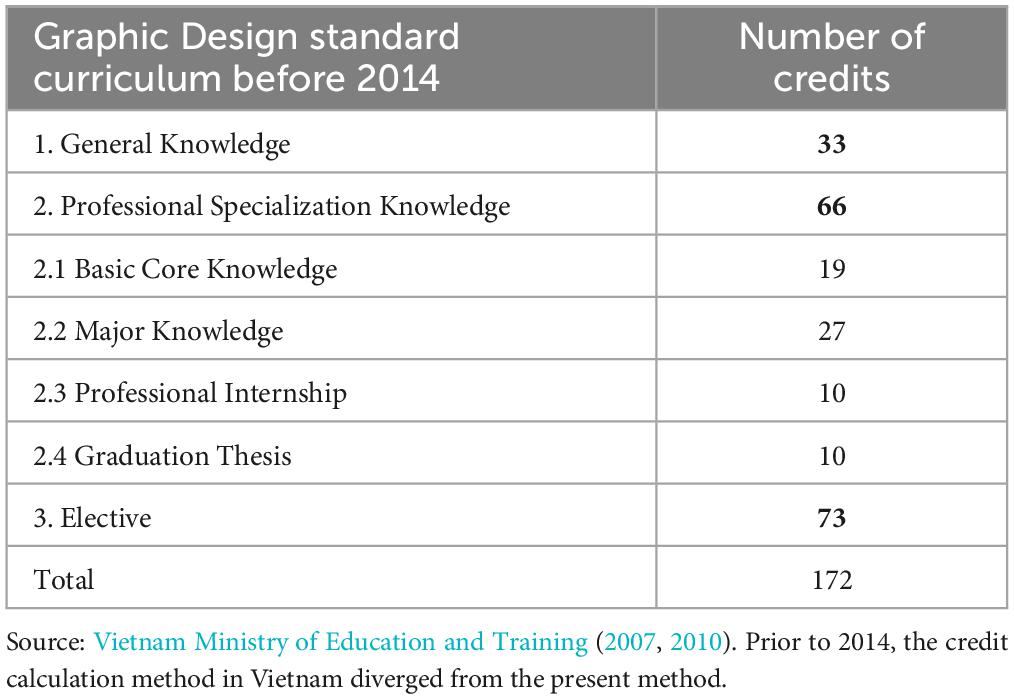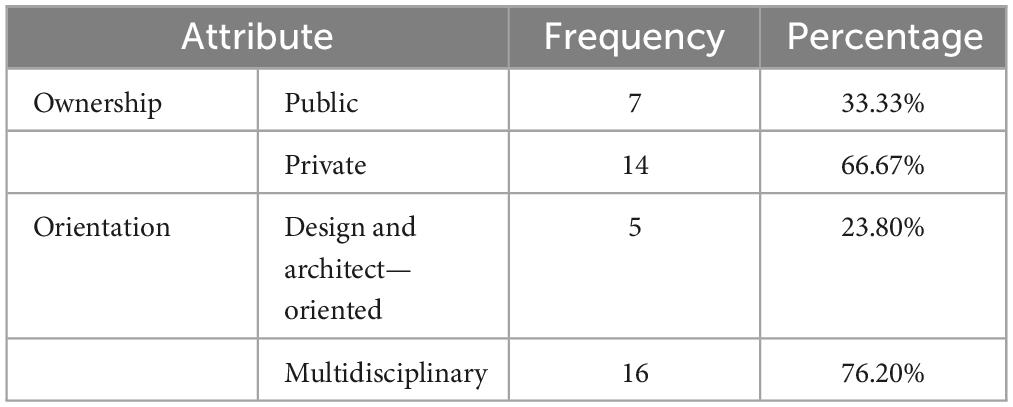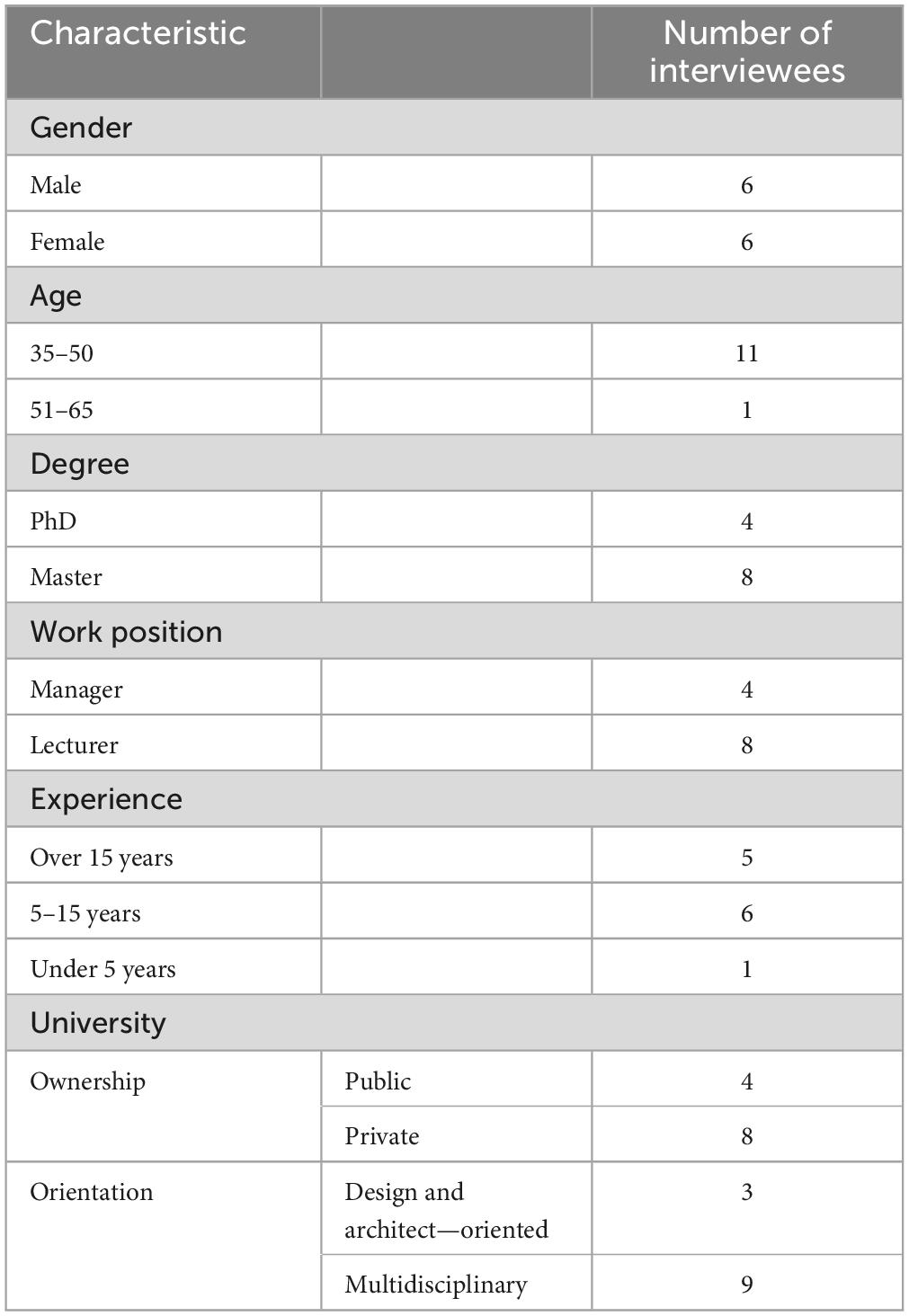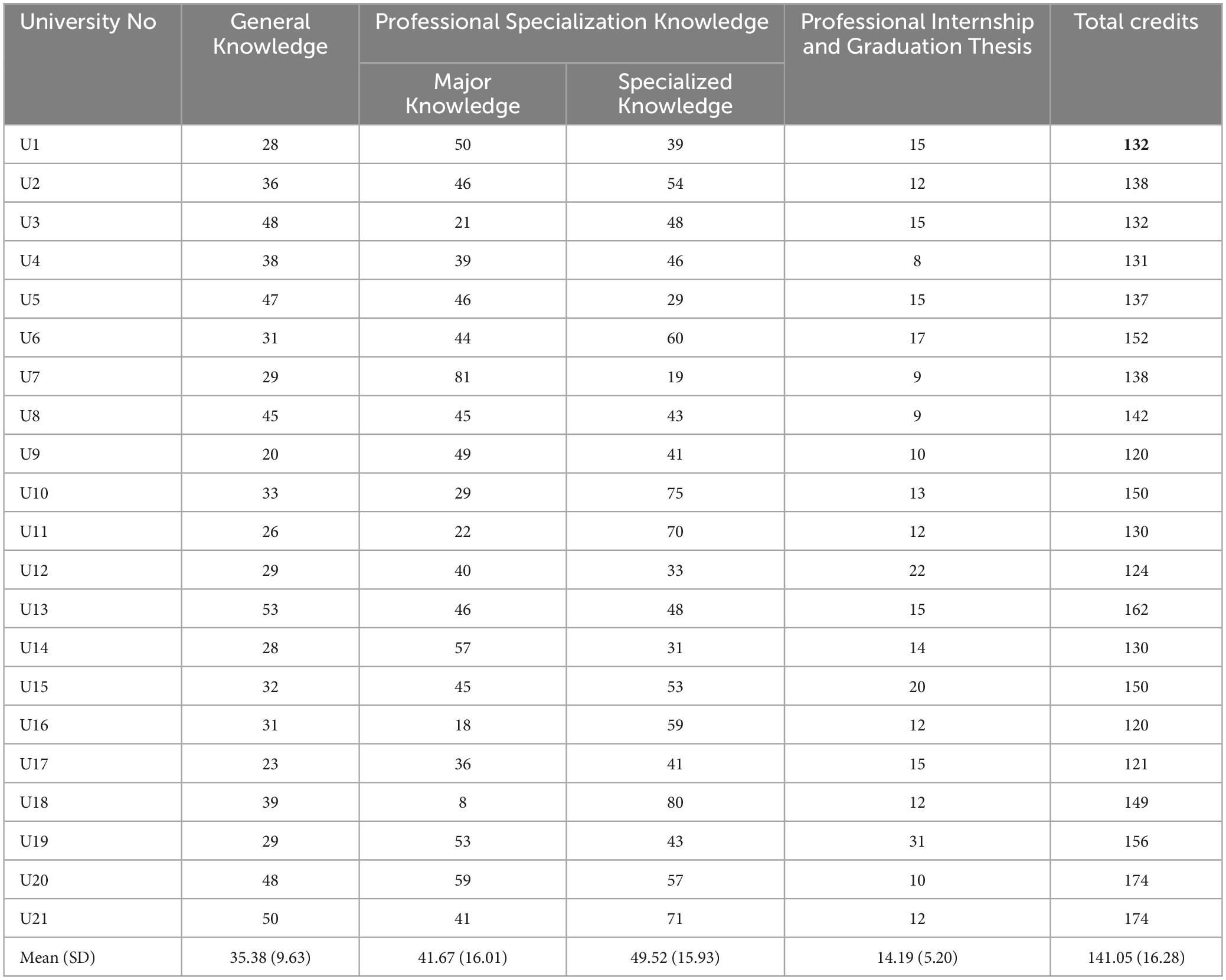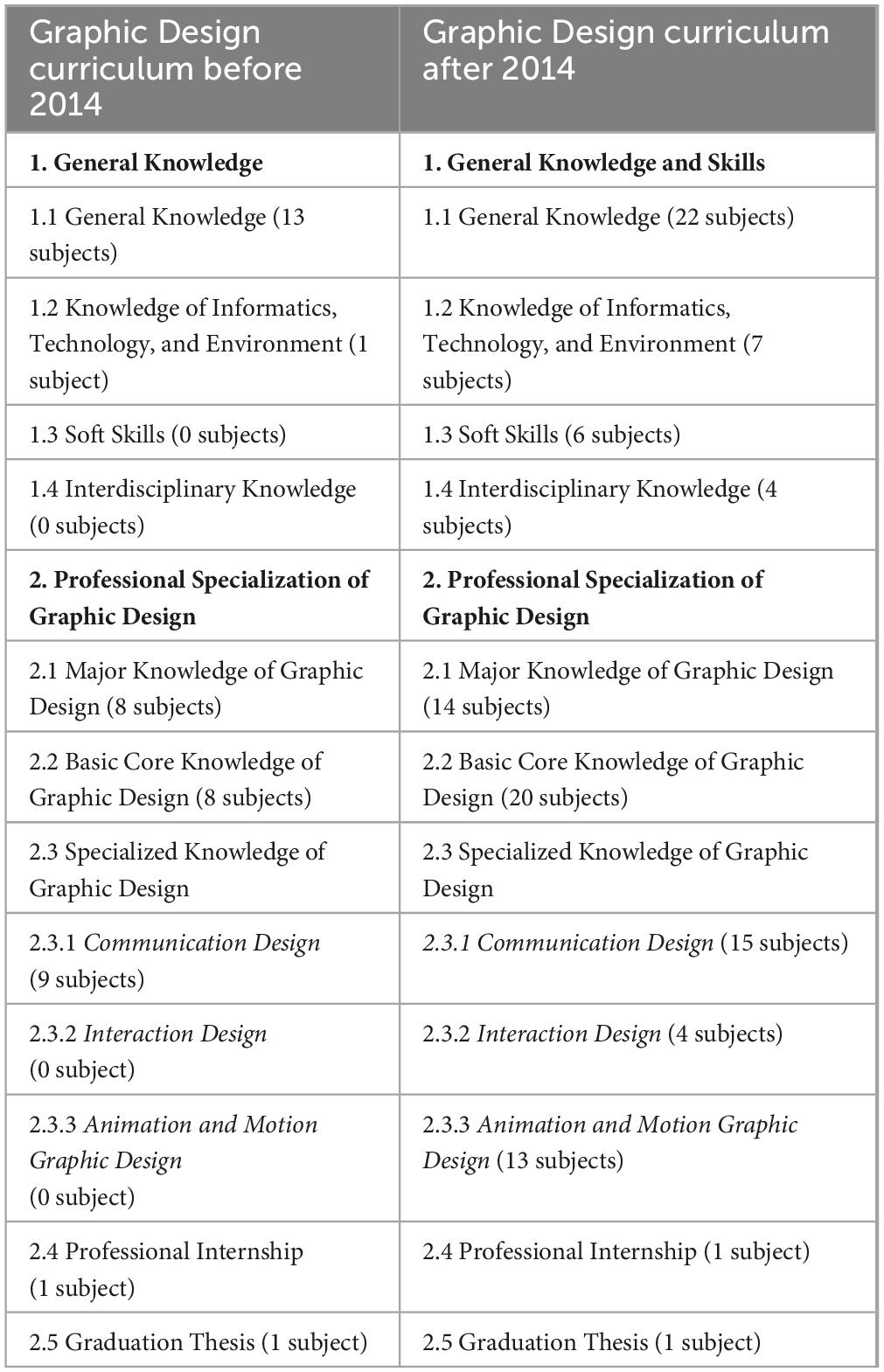- College of Planing and Design, Institute of Creative Industrial Design, National Cheng Kung University, Tainan, Taiwan
Introduction: The present study aims to examine the effects of autonomy policies implemented after 2014 on the undergraduate education of Graphic Design in Vietnam. The focus is on how these policies have influenced the transition of curricular content from traditional print-based principles to modern digital design methodologies.
Methods: This study employs a targeted analysis of specialized knowledge courses within Graphic Design programs, tracing their progression from conventional design principles for the print medium to modern digital design principles. It includes a comprehensive examination of curricular adjustments made in response to the evolving digital landscape.
Results: The analysis reveals a significant shift in the curriculum post-2014, from focusing predominantly on traditional design concepts such as typography, layout, and color theory to embracing digital design principles suitable for online platforms. These include responsive design, user experience/user interface, motion graphics, and animation. Empirical data presented in the study highlights the profound impact of increased institutional autonomy on this transformation.
Discussion: The transition to digital platforms marks a substantial development in Graphic Design education, aligning with the growing acceptance of interdisciplinary methodologies. The study discusses how these curricular changes are a direct response to the dynamic requirements of contemporary design practice, characterized by digital technology’s pervasive influence, interactivity, and sustainability considerations. The results emphasize the importance of adapting Graphic Design education to meet the demands of the modern industry, ensuring that graduates are well-equipped to thrive in the digital age.
1 Introduction
In recent years, a global trend toward enhancing university autonomy has been notable, granting institutions greater independence in internal operations (Le, 2019). This shift is pronounced in Vietnam, where the 2013 Law on Higher Education formalized institutional autonomy (Vietnamese National Assembly, 2012). Vietnamese universities now have more authority in shaping functions and academic programs, impacting the nation’s higher education development (Hayden and Lam, 2007; Salmi and Pham, 2019; Vo and Laking, 2020; Mai et al., 2022).
While the ramifications of university autonomy have been a subject of extensive research, there remains a significant gap in the understanding of its practical implications, particularly in the context of higher education curriculum design (Le, 2019). To address this gap, this study focuses on the curriculum framework of Graphic Design programs across 21 universities in Vietnam. Graphic Design, although not entirely novel in Vietnam, has historically occupied a specialized and somewhat marginalized position within the academic landscape. Until the 1990s, only a single institution, the University of Industrial Fine Art (2024), offered undergraduate programs in this field. However, recent years have seen an emergence of universities introducing Graphic Design specializations in response to the growing demand for design-related professions, driven by technological advancements, societal changes, and economic shifts (Cezzar, 2020). The field of Graphic Design is highly adaptable and dynamic, and the educational curriculum must evolve in tandem with changing market demands. This context makes Graphic Design an ideal case study for assessing the impact of university autonomy in Vietnam. This research seeks to examine the differences in teaching Graphic Design to undergraduate students in Vietnam before and after the implementation of university autonomy. Additionally, it aims to identify the driving forces that have prompted Vietnamese universities to adapt their approaches to teaching Graphic Design at the undergraduate level.
This study is significant as it sheds light on the nuanced implications of university autonomy within the context of curriculum design, particularly in the dynamic field of Graphic Design education. By addressing the following research questions, the study contributes to a more comprehensive understanding of the multifaceted effects of autonomy on Vietnamese higher education. Furthermore, the insights generated have the potential to inform policy decisions and pedagogical improvements, not only in Vietnam but also in the broader global context.
1. How has the teaching of Graphic Design for undergraduate students in Vietnam changed before and after the implementation of autonomy policies?
2. What factors and motivations have driven Vietnamese universities to modify their approaches to teaching Graphic Design to undergraduate students?
2 Literature review
2.1 The concept of university autonomy
The concept of university autonomy has been a subject of international discourse spanning several decades. It can be traced back to the Academic Freedom and Tenure Declaration, 1915, which initiated discussions and amendments over the years, occurring notably in 1926, 1940, 1969, and 1970 (Statement of Principles on Academic Freedom and Tenure, 1940). The significance of autonomy in Western higher education was reaffirmed in the 1988 Bologna Magna Charta Universitatum, emphasizing its pivotal role (University of Bologna, 1988). Subsequently, the matter of autonomy was deliberated upon in the 1992 International Conference in Sinaia, Romania, further reflecting its global relevance (UNESCO European Centre for Higher Education, 1992, p. 35).
University autonomy involves various dimensions and connotations. It signifies the independence of higher education institutions from governmental and societal control, underpinning principles of academic freedom and democratic self-governance. The core objective of university autonomy is to foster public awareness, thereby promoting academic freedom and tenure within educational institutions through established processes (UNESCO European Centre for Higher Education, 1992, p. 40). This, in turn, is intended to bolster the efficacy and quality of higher education. A specific facet of academic independence, curriculum autonomy, holds particular importance for educational institutions (Le, 2019).
In practical terms, university autonomy empowers institutions to make decisions related to their internal operations, encompassing areas such as management, academics, finances, and other critical domains, free from external governmental influence. With the grant of autonomy, universities possess the discretion to formulate their policies, recruit and manage faculty members and staff, design and execute curriculum, allocate financial resources, and establish their unique missions and objectives. This intricate concept of university autonomy not only underlines the institutional independence but also shapes the trajectory of higher education systems on a global scale.
2.2 University autonomy in Vietnam
The concept of university autonomy in Vietnam has historically been closely intertwined with a centralized and government-driven higher education system, a legacy of the former Soviet Union’s educational model (Tạp Chí Cộng Sản, 2008). Under this framework, universities operated with limited autonomy, as all activities, management practices, student enrollment, and educational quality were heavily influenced by principles of centralization and political cohesion. Financial reliance on government funding has been a defining characteristic of these institutions, further reinforcing their limited autonomy. While universities were allowed some flexibility in creating their own curricula and teaching methods, they remained subject to the overarching guidelines and study plans set forth by the Ministry of Education and Training (MOET) (Tạp Chí Cộng Sản, 2008).
Notably, the term “university autonomy” was not officially enshrined in legislative documents in Vietnam from 1979 to 2005, despite its occasional mention in media reports (Vietnam Political Bureau, 2011). It wasn’t until 2012 that the Vietnamese National Assembly formally recognized and articulated the concept of university autonomy within the legal framework (Vietnamese National Assembly, 2012). The Law on Higher Education in Vietnam, established in 2012, notably emphasized the autonomy of higher education institutions in the country. According to Article 32, subsection 21 of this law, it is explicitly stated that higher education institutions in Vietnam are granted the autonomy to operate according to their own discretion (Vietnamese National Assembly, 2012). This step marked a significant shift toward advancing higher education in Vietnam and allowed universities to exercise autonomy in five key domains, encompassing the development of programs, curricula, and teaching strategies; the organization of admission processes, training initiatives, and graduation recognition; the management of organizational structures; the mobilization, management, and utilization of resources; and the facilitation of domestic and international collaborations (Vietnamese National Assembly, 2012).
Over the course of time, a multitude of scholarly investigations have been undertaken with the aim of delving into the notion of university autonomy within the context of Vietnam (Le, 2019). Nevertheless, it is important to note that the current body of academic literature lacks research that delves into the precise effects of autonomy on curriculum design. This research gap signifies a significant area that has yet to be explored.
2.3 University autonomy in designing undergraduate Graphic Design curricula in Vietnam
Prior to the year 2014, a standardized national curriculum formulated by the Ministry of Education and Training (MOET) was strictly mandated for implementation across all Vietnamese universities, including Graphic Design programs. The Graphic Design curriculum, in particular, adhered to a standardized structure applied uniformly throughout the nation (Vietnam Ministry of Education and Training, 2010). This curriculum incorporated a core set of mandatory courses alongside a selection of optional courses for student enrollment and academic planning (Vietnam Ministry of Education and Training, 2021).
Table 1 illustrates the conversion of credits from the pre-2014 system to the current one. The pivotal year 2014 marked increased university autonomy, prompting substantial reforms in higher education, including curriculum, admissions, and pedagogy. Notably, a competency-based approach in curriculum development replaced existing courses with practical ones fostering skill development (Nguyen, 2019). Questions, particularly in Graphic Design, arose about admission transparency and curriculum changes (Dang Nguyen, 2013). This research explores Graphic Design teaching changes to undergraduates in Vietnam pre and post-2014, aligning with enhanced university autonomy. It aims to discern curriculum alterations and driving forces, illuminating how university autonomy influences Graphic Design education, providing insights into the evolving educational landscape.
3 Methodology
This study employed a mixed-methods approach, utilizing both secondary and primary data sources to comprehensively investigate the teaching of Graphic Design in Vietnamese universities. This study involves human participants and thus was reviewed and approved by National Cheng Kung University (Taiwan) ethics committee.
3.1 Secondary data
The secondary data source involves the examination of curricula from 21 Graphic Design programs offered by various universities in Vietnam. This secondary data is instrumental in providing an overview of Graphic Design education within the Vietnamese higher education landscape. To compile this dataset, a list of 28 educational institutions in Vietnam offering Graphic Design programs for the year 2023 was identified. Subsequently, the official websites of these institutions were accessed to gather information on the undergraduate curricula they provide. It is noteworthy that, out of the initial 28 institutions, only 21 institutions made their Graphic Design program curricula publicly accessible on their respective websites. For the other seven programs, due to confidential policies of the respective universities, their curricula are not disclosed, and thus, we can not approach to collect.
3.2 Primary data
In contrast, primary data collection hinges on in-depth interviews with 12 respondents who serve as Graphic Design lecturers and experts. This primary data source is instrumental in providing nuanced, insider perspectives on Graphic Design education in Vietnam. Written informed consent to participate in this study was provided by the participants.
Mixed method combining both primary and secondary data was employed as strategy for data analysis in numerous prior studies in social sciences (e.g., Harrison and Reilly, 2011; Schram, 2014). With data collected from two sources, the reliability and validity of data analysis are expected to be enhanced and ensured.
3.2.1 Characteristics of participants universities and interviewees
Table 2 herein presents a comprehensive overview of the characteristics of the 21 universities that were subjected to examination in this study. These institutions represent a diverse cross-section of Vietnamese higher education, each offering a Graphic Design program, and as such, constitute a substantial basis for the research investigation.
The primary data for this study was collected through in-depth interviews with 12 knowledgeable and experienced respondents who are Graphic Design lecturers and experts. These interviewees possess a comprehensive understanding of the Graphic Design curriculum development in Vietnamese universities, both pre- and post-2014, making them well-qualified sources of insights into the modifications, benefits, challenges, and motivations underpinning program and course alterations. The interviewees were recruited through a convenient network which had previously contacts with one of the co-authors of this study. Their profiles and qualifications are presented in Table 3 for reference.
4 Results and discussion
4.1 Differences in the overall structure of Graphic Design curriculum before and after autonomy policy in 2014
Analysis of curriculum structures indicates significant changes in undergraduate Graphic Design programs post the 2014 autonomy policy implementation. Key findings are outlined in Tables 4, 5. Since the initiation of the 2014 autonomy policy, Vietnamese universities have significantly transformed undergraduate Graphic Design curricula, particularly in credit allocation. Table 4 indicates a notable shift, with the majority reducing required credits compared to the pre-2014 standard. Two universities (U20 and U21) maintained similar credit levels, while the remaining 19 significantly reduced credits, ranging from 132 to 156. The average number of credits for Graphic Design courses is now 141.05 (SD 16.28), a significant decrease from the pre-2014 standard.
Regarding curriculum structure, while the overall structure remains relatively consistent pre and post-2014, Table 5 highlights significant adjustments in each component. The pre-2014 standard curriculum has General Knowledge and Professional Specialization in Graphic Design In the post-2014 curricula of 21 universities, a slight modification is noted in the former’s name, now termed General Knowledge and Skills while the latter retains its original designation as Professional Specialization in Graphic Design.
4.2 Distinctive aspects of curriculum components
Examining both components indicates significant disparities in the Graphic Design curriculum pre and post-2014. General Knowledge and Skills, mandated by the Ministry of Education and Training (MOET) before 2014, covered topics like the Revolutionary Policies of the Vietnamese Communist Party, Introduction to Education, and Vietnamese Culture. Post-2014, with increased institutional autonomy, universities expanded General Knowledge courses to include Soft Skills, and Interdisciplinary Knowledge. This aims to provide a holistic education meeting modern workforce and societal needs.
In Professional Specialization in Graphic Design, both pre- and post-2014 curricula consist of five subject clusters. Post-2014, there’s a more diverse range of subjects, including expanded optional courses. The Specialized Knowledge cluster in Graphic Design post-2014 offers increased opportunities to explore various specializations within Graphic Design, introducing new ones like Interaction Design and Animation and Motion Graphic Design. These adjustments align with the evolving demands of the Graphic Design industry, providing students a more comprehensive educational experience.
In the subsequent subsections, a more in-depth exploration of the specific modifications and the motivations driving these changes will be provided.
4.3 Differences in General Knowledge and Skills courses before and after the autonomy policy in 2014
The implementation of the autonomy policy in 2014 prompted Vietnamese universities to revise their Graphic Design curricula, introducing new subjects, particularly in the clusters of Knowledge of Informatics, Technology, and Environment, Soft Skills, and Interdisciplinary Knowledge (refer to Table 6). All interviewed experts unanimously supported these additions, recognizing their significance. These changes align with the rapid advancement of technology and design tools and the need for students to gain a comprehensive understanding of how their field integrates into the broader economic and societal context. Interviewee 3 expressed this perspective, stating:
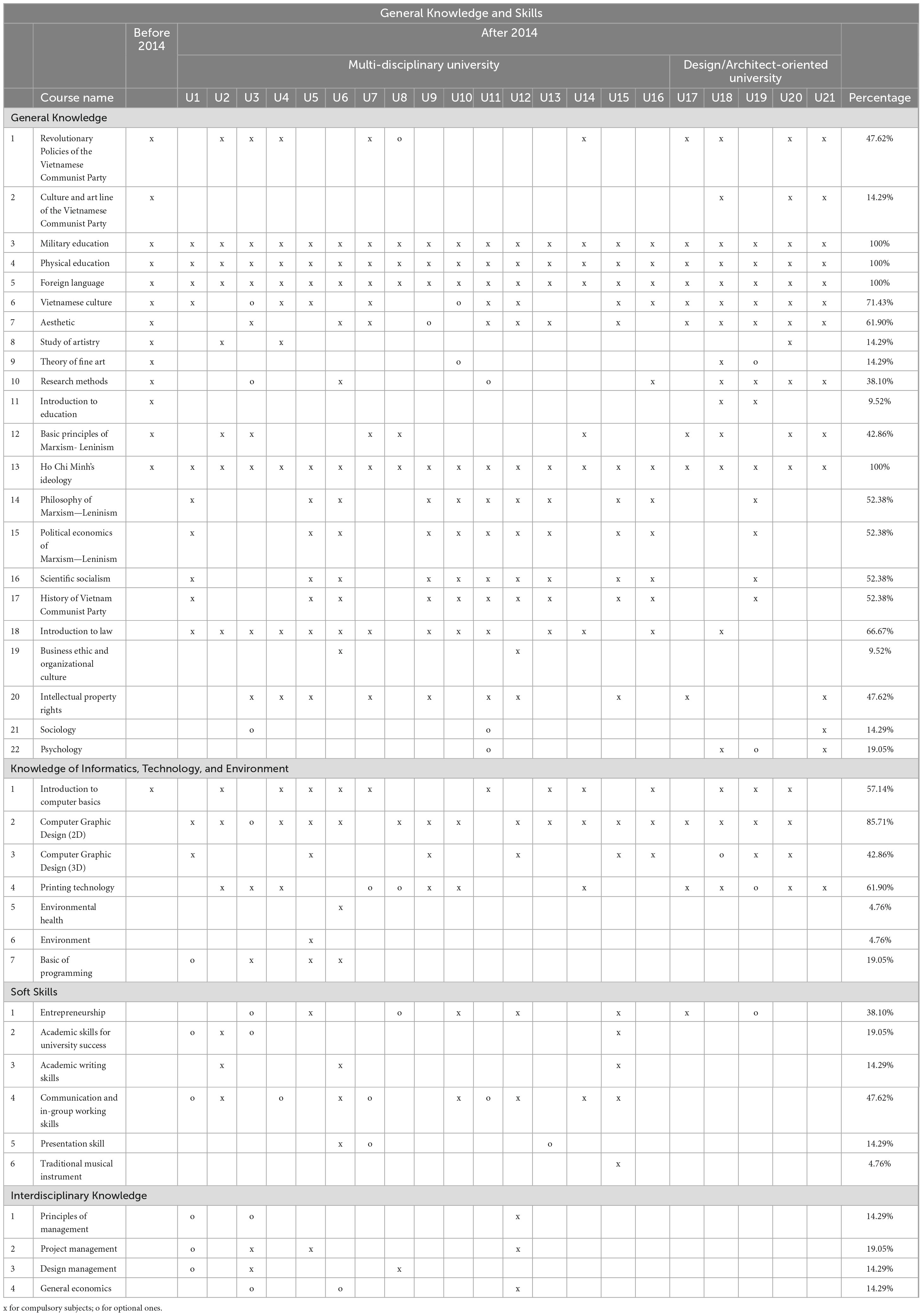
Table 6. Differences in Teaching General Knowledge and Skills for Graphic Design before and after 2014.
“Graphic Design must adapt to a changing landscape. For instance, a concert poster is not limited to physical displays but extends to digital platforms like television, websites, and apps. Therefore, modern designers need training in technology, informatics, environmental considerations, and interdisciplinary expertise.” (Interviewee 3)
Table 6 reveals two groups among the 21 surveyed universities: 16 multidisciplinary (U1-U16) and five Design/Architect-oriented universities (U17-U21). The former offers a broader subject range, introducing new subjects in General Knowledge and Skills, while the latter maintains a curriculum akin to pre-2014. Interviewee 3 attributes Design/Architect-oriented universities’ reluctance to change to human resource shortages, stating, “These institutions may lack faculty in new disciplines. In multi-disciplinary universities, new subjects may be taught by teachers from other departments.”
This curriculum gap highlights varied responses to autonomy. Multi-disciplinary universities actively diversify, offering a wide subject range reflecting contemporary Graphic Design’s interdisciplinary nature. In contrast, Design/Architect-oriented universities show inertia, possibly due to resource constraints and faculty expertise. This underscores the heterogeneous nature of Vietnam’s higher education response to autonomy, indicating varying capacities for innovation. A comprehensive support system and faculty development are crucial for a smoother transition. Further research is needed to assess curriculum differences’ long-term impact on students’ skills and readiness for the evolving job market and design industry.
4.4 The differences regarding Major Knowledge of Graphic Design before and after autonomy policy in 2014
Within the domain of Major Knowledge in Graphic Design, eight subjects from the pre-2014 curriculum continue to be offered by 21 studied universities (number 1–8 in Table 7). In addition to this, a number of new courses have been introduced in post-2014. Remarkably, all 21 surveyed universities offer a course, namely Photography. This is followed by the following subjects: Fundamentals of Graphic Design (76.19%), History of Design (66.70%), and Design Thinking (57.14%).
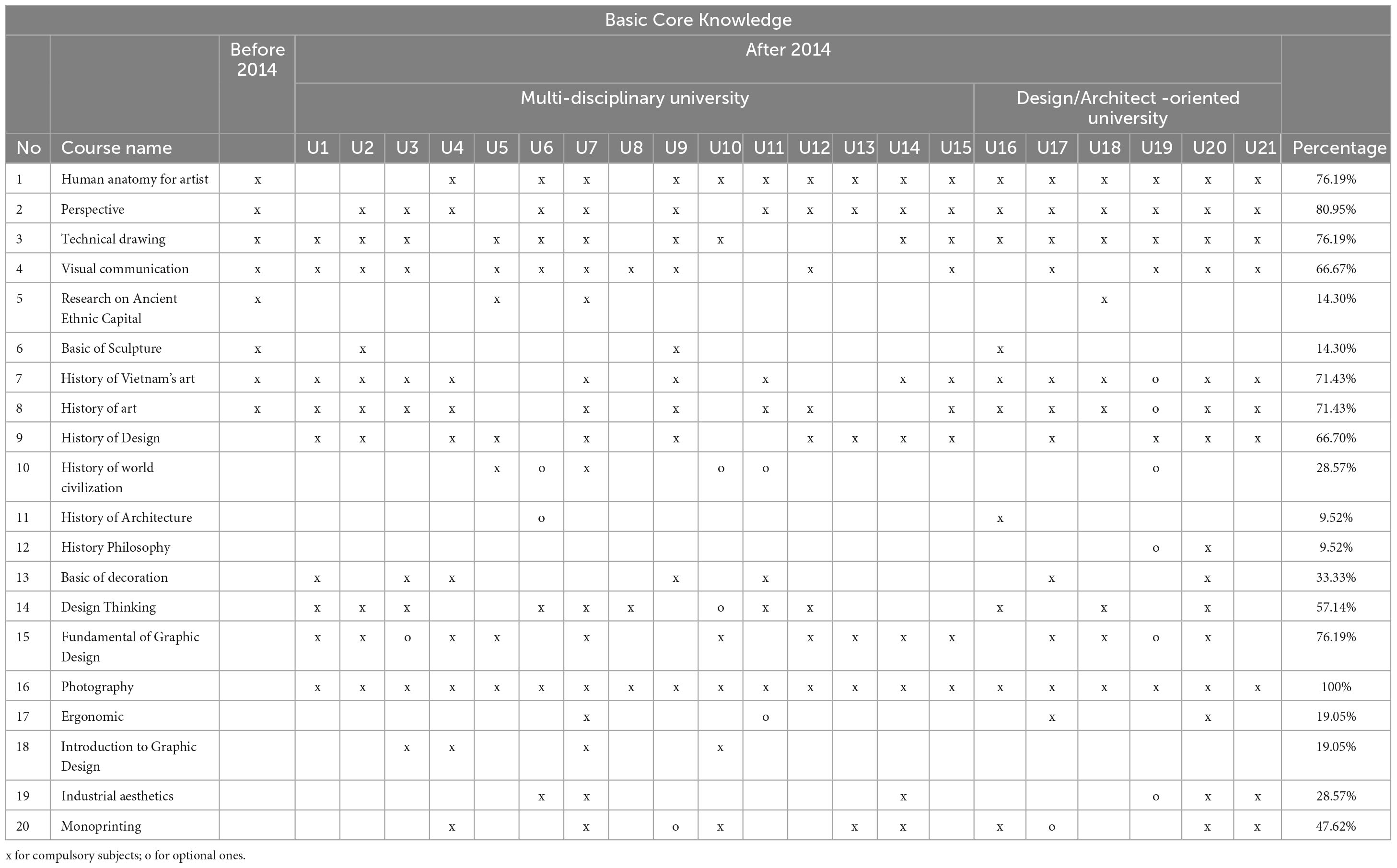
Table 7. The differences regarding Basic Core Knowledge subject teaching for Graphic Design students before and after 2014.
Out of the 21 surveyed universities, it was found that only three universities (U5, U7, U18) offer instruction subject Ancient Ethnic Capital and three universities (U2, U9, U16) offer instruction subject Basic of Sculpture. The subjects exhibiting the most substantial level of adoption is Perspective with a rate of 80.95%. The subjects Human Anatomy for Artists and Technical Drawing exhibit the second greatest adoption rate, with both subjects being adopted by 76.19% of the universities. Six out of eight subjects have been incorporated into the curriculum framework by more than 60% of educational institutions following the year 2014. Two subjects History of Architecture and History Philosophy exhibit notably lowest rates of 9.52%.
Substantial changes in the curriculum framework were witnessed after 2014, as numerous institutions granted students the freedom to select subjects across all knowledge domains. This shift resulted in the introduction of twelve new subjects within the basic knowledge group of specialized fields. However, it is worth noting that the implementation rates for each of these new subjects displayed significant disparities, ranging from 9.52 to 100%.
The inclusion of the Photography subject in the curriculum of all universities has been universally embraced, with a 100% adoption rate. Incorporating Photography into Graphic Design education can enhance students’ visual awareness. Analyzing and working with photographs helps students develop a keen eye for composition, lighting, color, and other visual elements, which are crucial skills in Graphic Design. Photography provides real-world examples of design principles in action. Students can study how photographs effectively communicate messages, evoke emotions, and convey information, which can inspire and inform their own design work (Interviewees No. 1, 2, 10, and 12). Encouraging students to use Photography as a learning and inspiration tool while fostering their creativity and broader design skills will lead to a more comprehensive education (Interviewees No. 4 and 5).
The information in Table 7 shows that only four out of the 21 institutions include the subject of Ergonomics in their academic curriculum. According to Interviewees 5, 8, and 9, the inclusion of Ergonomics within the curriculum has the potential to cultivate students who possess comprehensive knowledge of design and are capable of producing genuinely practical and user-friendly products.
“Some educational institutions may overlook the significance of ergonomics in design, unaware of its broad and complex nature involving how people interact with their surroundings. The complexity of ergonomics instruction may pose challenges within curriculum constraints, potentially leading other design principles such as performance, utility, and aesthetics to take precedence in certain educational establishments.”
In addition, there are also opinions (Interviewees No.11 and 12) that the intricate nature of ergonomics might provide difficulties in the teaching and learning process, particularly in educational programmes that have limited time available. Ergonomics involves a multifaceted body of knowledge that encompasses human anatomy, psychology, engineering, and design principles, all of which require substantial time to master thoroughly. In an environment where curricula are densely packed and time is a precious commodity, educators might struggle to deliver comprehensive ergonomics training effectively. Students, on their part, might find it challenging to assimilate the intricate concepts of ergonomics within the limited time allotted for this subject matter. This potential crunch may compel educational institutions to reassess their curricular priorities. Consequently, some institutions might make a deliberate choice to de-emphasize ergonomics in favor of topics that are perceived to be more critical or more feasible to teach within the available time frame. This decision, while practical on some fronts, risks depriving students of essential knowledge and skills that are fundamental to ensuring safety, efficiency, and wellbeing in various professional practices. Hence, it is plausible that certain educational institutions may opt to prioritize alternative factors above the emphasis on ergonomics.
The subject Visual Communication in the Graphic Design curriculum was implemented by 66.67% of universities before 2014 and continued to be part of the curriculum after 2014. Visual Communication involves conveying ideas through visual elements like images, typography, symbols, colors, and layout. It’s a broader concept that extends beyond Graphic Design. On the other hand, Fundamentals of Graphic Design is a more specific subject that focuses on core design principles and techniques for creating visual content in various mediums. This subject was also delivered by 66.67% of the universities. Both subjects are essential in design education, providing students with a comprehensive understanding of visual communication and design principles (Interviewees No.2, 7, and 11).
4.5 Differences in Major Knowledge of Graphic Design before and after the autonomy policy in 2014
In Graphic Design Knowledge, all 21 surveyed universities maintain eight pre-2014 subjects (refer to Table 8, numbers 1–8). Post-2014, new courses are introduced, notably Photography (100%), Fundamentals of Graphic Design (76.19%), History of Design (66.70%), and Design Thinking (57.14%). Three universities offer instruction in two specific subjects, with Perspective having the highest adoption rate at 80.95%. Human Anatomy for Artists and Technical Drawing follow at 76.19%. Six of eight existing subjects have been adopted by over 60% of institutions since 2014, while three exhibit lower inclusion rates (14.30 to 28.60%).
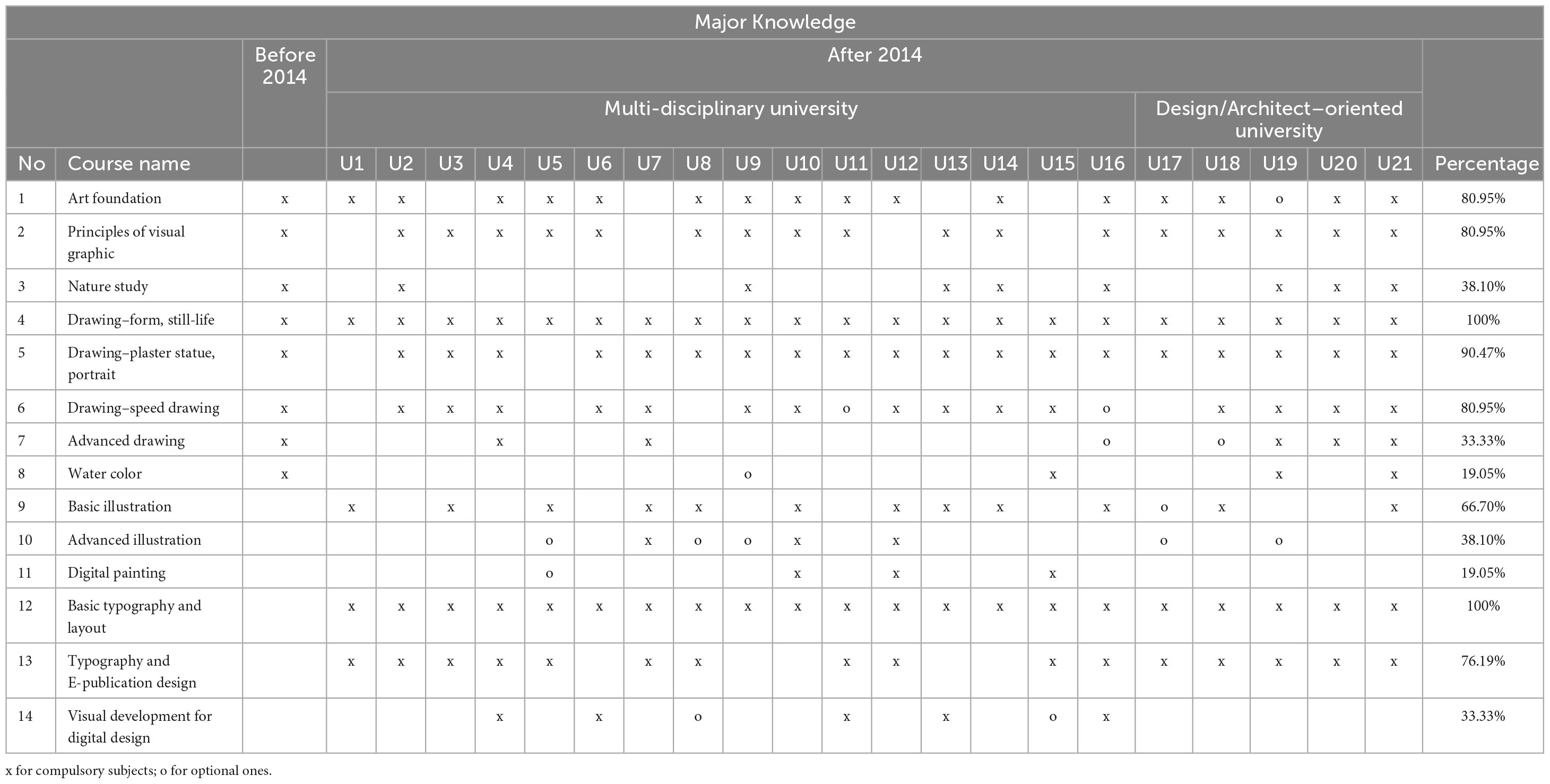
Table 8. Differences in Major Knowledge teaching subject for Graphic Design students: multi-disciplinary versus Design/Architect-oriented universities.
A considerable transformation in the curriculum framework was witnessed after 2014, when many institutions began to grant students the freedom to select subjects across all knowledge domains, introducing twelve new subjects within the Basic Knowledge group of specialized fields. It’s important to highlight that the implementation rates for these new subjects displayed substantial variations, ranging from 9.52 to 100%.
The analysis further reveals that only four out of the 21 institutions include the subject of Ergonomics in their academic curriculum. The addition of Ergonomics has the potential to cultivate students with comprehensive knowledge in design, capable of producing products that are genuinely practical and user-friendly, as expressed by Interviewees No. 5, 8, and 9. However, it is noted that the complexity of ergonomics, particularly within curricula with time constraints, could be challenging to teach and learn, and other design principles might be prioritized above ergonomics. This suggests that certain institutions might emphasize other facets of design, such as performance, utility, and aesthetics, above ergonomics (Interviewees No. 11 and 12).
The subject Visual Communication which involves conveying ideas through visual elements, is implemented by 66.67% of universities both before and after 2014. It extends beyond Graphic Design to encompass broader communication concepts. Fundamentals of Graphic Design, another fundamental subject, is delivered by the same percentage of universities. These two subjects are instrumental in design education, providing students with a comprehensive understanding of visual communication and core design principles (Interviewees No. 2, 7, and 11).
The observed changes in Major Knowledge in Graphic Design highlight the evolving nature of design education in Vietnam. The introduction of new subjects, along with varying adoption rates, suggests that universities are adapting to the industry’s dynamic demands and exploring opportunities to enhance their Graphic Design programs. Moreover, the role of these subjects in fostering well-rounded designers and equipping students with practical, real-world skills should not be underestimated. Further exploration is needed to evaluate the impact of these changes on the preparedness of Graphic Design graduates for the contemporary job market and industry demands.
4.6 Differences in teaching specializations for Graphic Design students: multi-disciplinary versus Design/Architect-oriented universities
The curriculum transformation for Graphic Design programs in Vietnam underwent a significant shift before 2014, primarily focusing on traditional Graphic Design. However, post-2014 witnessed a notable division, creating three specializations: Communication Design, Interaction Design, and Motion Graphic Design/Animation (See Table 9). This shift, propelled by university autonomy and technological advancements, broadens skill sets and employment opportunities. Students can now concentrate on proficiencies aligned with specific career interests, addressing market trends and technological advancements, enabling tailored education to meet professional aspirations and diverse job market demands.
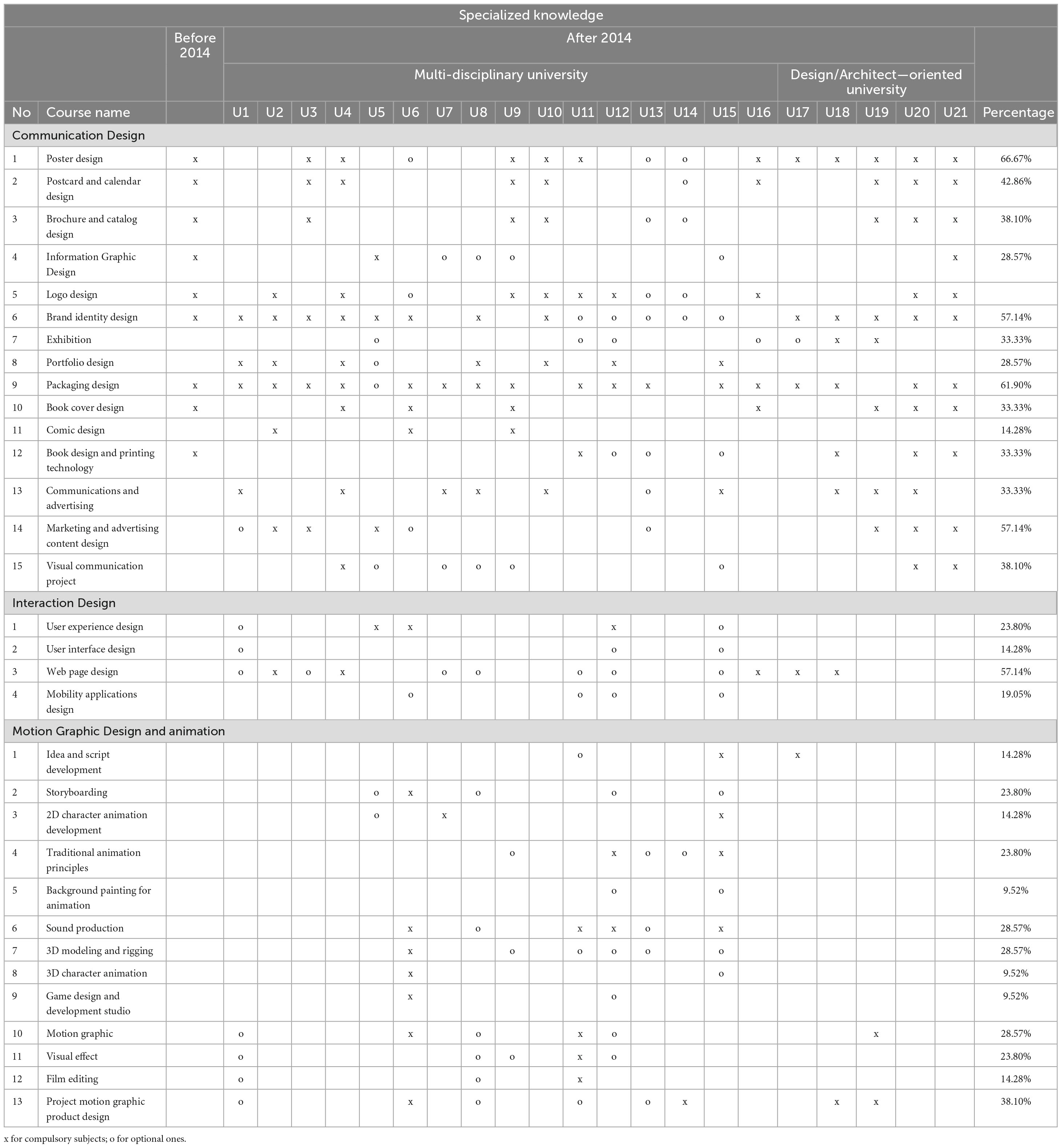
Table 9. Differences in specialized knowledge courses teaching for Graphic Design students between different types of universities: multidisciplinary vs. Design/Architect-oriented.
Yet, differences in adopting specialized subjects exist between multidisciplinary and Design/Architect-oriented universities. Design/Architect-oriented institutions (U17 to U21) prioritize communication-related subjects, with new additions, while multidisciplinary universities (U1 to U17) have a higher proportion of subjects from the two new knowledge groups.
Disparities may be attributed to political, financial, and commercial factors. Some institutions may not fully comprehend specialization importance, with the lack of an established labor market in Vietnam potentially contributing to underestimating their significance. Additionally, Interaction Design and Motion Graphics/Animation fields require substantial infrastructure, often lacking in public institutions, particularly those focused on design and architecture.
The investment required for specialized subjects poses challenges for some universities, involving time, effort, and resources. Developing curricula, obtaining necessary resources, and retaining faculty expertise are financially and professionally demanding. University autonomy permits program alignment with market demands and commercial goals. Institutions may prioritize high-demand professions in a limited job market for these specializations. Interviewees emphasize the digital landscape’s growing importance, hinting at future growth.
The Graphic Design curriculum shift signifies universities adapting to an evolving industry, offering diverse specializations empowering students for desired career paths, enhancing job market preparedness. Further exploration is needed to evaluate the impact of the content changes of the units/lessons on the preparedness of Graphic Design graduates for the contemporary job market and industry demands.
4.7 Professional Internship and Graduation Thesis in Graphic Design programs: a comparative analysis before and after 2014
In the domains of Professional Internship and Graduation Thesis (See Table 10), no notable changes in composition before and after 2014 are apparent. The Graphic Design curriculum’s fundamental structure and purpose for these components seem to have consistently endured. Essential prerequisites for graduation, involving credit requirements and Graduation Thesis completion, have persisted with minimal alteration, ensuring stable academic standards.
Post-2014, a significant development is the widespread integration of internship courses into the majority of undergraduate Graphic Design programs, reaching approximately 95.23%. This aligns with higher education’s trend emphasizing practical experience for students, recognizing the value of hands-on learning in preparing for professional careers.
While Professional Internship courses are prevalent, there may be variations in content and requirements across institutions, allowing customization to regional and industry needs. The continued structure of internship and thesis components underscores their consistent and vital role in Graphic Design education. The introduction of internships reflects a commitment to enhancing students’ job market readiness. Further research could explore internship program quality, outcomes, and their impact on Graphic Design students’ professional development.
5 Discussion
This study examines the current state of undergraduate Graphic Design education in Vietnam, focusing on the impact of autonomy rules implemented after 2014. Through a thorough analysis, the researchers explore the extent to which these policies have influenced the curricula offerings of higher education institutions, leading to notable shifts in the field. A notable transition from conventional design principles to the domain of digital design and contemporary multidisciplinary approaches has been identified.
The empirical data presented in this study highlight the significant structural transformation that has taken place in the field of Graphic Design education, both prior to and subsequent to the year 2014. This shift aligns closely with the observed trend of heightened institutional autonomy. Prior to 2014, the curricula mostly prioritized conventional design principles, with a particular emphasis on elements such as Typography, Layout, Color Theory, and Print Manufacturing. In contrast, the landscape after the year 2014 demonstrates a notable shift toward digital design, reflecting the exponential expansion of online platforms and digital media.
The current curricula include incorporating design principles for websites, social media platforms, mobile applications, and diverse digital platforms. The incorporation of responsive design and user experience/user interface (UX/UI) design has become an essential aspect of Graphic Design education. Students possess the necessary abilities to create designs that effectively adjust to a wide range of screen sizes and devices, with a focus on delivering the best possible user experiences. Multimedia features, including motion graphics, animation, and interactive design, have become essential components in facilitating productive collaboration between developers and producing functional and visually captivating web designs. Courses have expanded their scope to encompass global design trends and cultural awareness, acknowledging the interdependent nature of our global society and the necessity of creating for varied populations. The inclusion of Specialized Knowledge courses in the curriculum is a response to the current state of design practice, which is marked by the prevalence of digital media, interaction, sustainability concerns, and the need for a broad range of skills to navigate the demands of the present-day design age effectively.
This study contributes to the literature on the impact of university autonomy policies in Vietnam (e.g., Nguyen et al., 2016; Vo and Laking, 2020; Do and Mai, 2022). Nevertheless, to the best of our knowledge, this study is one of the first to specifically focus on how university autonomy policies have influenced the change in curriculum design among Vietnamese higher education institutions, using the Graphic Design program as an example. Another study that also examines the change in curriculum design following autonomy policies is that of Vu et al. (2023). In this work, the authors explore how mathematics-related subjects in undergraduate business programs in Vietnam have evolved since 2014.
6 Limitations and implications
While this study provides an early exploration of Graphic Design education in Vietnam, it is essential to acknowledge its limitations. The findings are based on empirical data collected from a specific set of universities and may not fully represent the entire spectrum of institutions in the country. Future research is anticipated to address this limitation by incorporating more inclusive data, encompassing both secondary sources (28 Graphic Design programs nationwide) and primary sources (involving over 12 interviewees, as in the current study).
Furthermore, the study offers a snapshot of the state of Graphic Design education at a specific time, i.e., cross sectional data by nature. Future studies on this topic are suggested to collect data in a longitudinal way in order to avoid this drawback.
This study has far-reaching implications in both theoretical and practical contexts. The transition in Graphic Design curricula indicates broader shifts in design education worldwide, where traditional print-focused approaches are making way for digital and interdisciplinary expertise. Together with future findings on the content of the units/lessons, these studies can inform curriculum development in Graphic Design and other creative disciplines by exploring the need to adapt to evolving industry requirements.
Moreover, this study holds practical implications for educational institutions and policymakers. It underscores the importance of granting autonomy to universities, allowing them to keep pace with the dynamism of design fields. Institutions should focus on equipping students with a comprehensive skill set that aligns with the demands of the digital age. As one of the explorations of Graphic Design education in Vietnam, this study paves the way for further research in the field, delving deeper into the effectiveness of new curricula, the impact on student outcomes, and the evolving roles of educators. It also offers a valuable reference point for institutions in Vietnam and beyond seeking to enhance their Graphic Design programs and prepare students for the challenges of contemporary design practice.
Data availability statement
The original contributions presented in this study are included in this article/supplementary material, further inquiries can be directed to the corresponding author.
Ethics statement
The studies involving human participants were approved by the National Cheng Kung University (Taiwan) Ethics Committee. Written informed consent to participate in this study was provided by the participants.
Author contributions
TQ: Formal analysis, Resources, Writing – original draft. SL: Writing – review & editing. CY: Writing – review & editing.
Funding
The authors declare that no financial support was received for the research, authorship, and/or publication of this article.
Acknowledgments
This study would not have been possible without the enthusiastic assistance of the participants and colleagues at my institution. A heartfelt thanks to all of them for their support.
Conflict of interest
The authors declare that the research was conducted in the absence of any commercial or financial relationships that could be construed as a potential conflict of interest.
Publisher’s note
All claims expressed in this article are solely those of the authors and do not necessarily represent those of their affiliated organizations, or those of the publisher, the editors and the reviewers. Any product that may be evaluated in this article, or claim that may be made by its manufacturer, is not guaranteed or endorsed by the publisher.
References
Academic Freedom and Tenure Declaration (1915). American Association of University Professors. Available online at: https://www.aaup.org/NR/rdonlyres/A6520A9D-0A9A-47B3-B550-C006B5B224E7/0/1915Declaration.pdf (accessed September 27, 2023).
Cezzar, J. (2020). Teaching the designer of now: A new basis for graphic and communication design education. She Ji J. Des. Econ. Innov. 6, 213–227.
Dang Nguyen (2013). Tù’ năm 2013, các ngành khối ngh.ê thu.ât chi̇ thi môn năng khiếu [Since 2013, arts-related majors have only required aptitude tests]. Ho Chi Minh City: Thanh Niên.
Do, H. T. H., and Mai, A. N. (2022). Policies on university autonomy in Vietnam. J. Furth. High. Educ. 46, 575–585.
Harrison, R. L., and Reilly, T. M. (2011). Mixed methods designs in marketing research. Qual. Mark. Res. Int. J. 14, 7–26.
Hayden, M., and Lam, Q. T. (2007). Institutional autonomy for higher education in Vietnam. High. Educ. Res. Dev. 26, 73–85. doi: 10.1080/07294360601166828
Le, N. H. (2019). University autonomy is inevitable for the fundamental and comprehensive innovation of education in Vietnam. Available online at: http://lyluanchinhtri.vn/home/en/index.php/cadre-training/item/611-university-autonomy-is-inevitable-for-the-fundamental-and-comprehensive-innovation-of-education-in-vietnam.html (accessed September 11, 2023).
Mai, A. N., Do, H. T. H., Mai, C. N., and Nguyen, N. D. (2022). Models of university autonomy and their relevance to Vietnam. J. Asian Public Policy 15, 394–410. doi: 10.1080/17516234.2020.1742412
Nguyen, H. T., Hamid, M. O., and Moni, K. (2016). English-medium instruction and self-governance in higher education: The journey of a Vietnamese university through the institutional autonomy regime. High. Educ. 72, 669–683.
Nguyen, V. P. (2019). Tăng cường tự chủ chương trình đào tạo - yếu tố căn bản nâng cao chất lượng đào tạo của các Trường Đại học Việt Nam [Enhancing curriculum autonomy – fundamental factor in advancing the quality of education at Vietnamese universities]. Tạp Chí Giáo Dục 79, 96–99.
Salmi, J., and Pham, L. T. (2019). Academic governance and leadership in Vietnam: Trends and challenges. J. Int. Comp. Educ. 8, 103–118. doi: 10.14425/jice.2019.8.2.103
Schram, A. B. (2014). A mixed methods content analysis of the research literature in science education. Int. J. Sci. Educ. 36, 2619–2638.
Statement of Principles on Academic Freedom and Tenure (1940). American association of university professors. Available online at: https://www.aaup.org/report/1940-statement-principles-academic-freedom-and-tenure (accessed September 27, 2023).
Tạp Chí Cộng Sản (2008). Mô hình giáo đục đại học ở một số nước [The Higher Education models in some countries]. Available online at: https://tapchicongsan.org.vn/web/guest/thong-tin-ly-luan/-/2018/2767/mo-hinh-giao-duc-dai-hoc-o-mot-so-nuoc.aspx (accessed September 27, 2023).
UNESCO European Centre for Higher Education (1992). International conference on academic freedom and university autonomy, Sinaia, Romania. Bucharest: UNESCO European Centre for Higher Education.
University of Bologna (1988). Observatory magna charta universitatum. Bologna: University of Bologna.
University of Industrial Fine Art (2024). Lịch sử trường đại học mỹ thuật công nghiệp [The history of the university of industrial fine arts]. Hanoi: University of Industrial Fine Art.
Vietnam Ministry of Education and Training (2007). Quyết định số 43/2007/QĐ-BGDĐT của Bộ Giáo dục và Đào tạo: Ban hành Quy chế đào tạo đại học và cao đẳng hệ chính quy theo hệ thống tín chỉ [Decision No. 43/2007/QĐ-BGDĐT of the ministry of education and training: Issuance of regulations for undergraduate. Hanoi: Vietnam Ministry of Education and Training.
Vietnam Ministry of Education and Training (2010). Thông tư số 28/2010/TT-BGDĐT Ban hành chương trình khung Giáo dục Đại học khối ngành Văn hóa - Nghệ thuật - Thông tin, trình độ Đại học và Cao đẳng [Circulars No. 28/2010/TT-BGDÐT issued by the ministry of education and training, establishing the framewor thuvienphapluat. Hanoi: Vietnam Ministry of Education and Training.
Vietnam Ministry of Education and Training (2021). Quy chế đào tạo trình độ Đại học - Ban hành kèm theo Thông tư số 08/2021/TT-BGDĐT của Bộ Giáo dục và Đào tạo [Regulations on university-level education - issued in accordance with circular No. 08/2021/TT-BGDĐT by the ministry of education and training]. Hanoi: Vietnam Ministry of Education and Training.
Vietnam Political Bureau (2011). Nghị quyết số 14-NQ/TW Bộ Chính trị khoá IV vế cải cách giáo dục [Resolution No. 14-NQ/TW of the 4th political bureau of Vietnam on educational reform]. Hanoi: Communist Party of Vietnam Online Newspaper (Báo Điện Tử Đảng Cộng Sản Việt Nam).
Vietnamese National Assembly (2012). Luật Giáo dục Đại học [Law No. 08/2012/QH13 On Higher Education]. Thuvienphapluat. Hanoi: Vietnamese National Assembly.
Vo, M. T. H., and Laking, R. (2020). An institutional study of autonomisation of public universities in Vietnam. High. Educ. 79, 1079–1097. doi: 10.1007/s10734-019-00457-6
Keywords: Graphic Design, autonomy policies, undergraduate education, curriculum adjustment, design education
Citation: Quyen TTL, Liou S and Yang CH (2024) Teaching Graphic Design for undergraduate students in Vietnam: a curriculum analysis. Front. Educ. 9:1354438. doi: 10.3389/feduc.2024.1354438
Received: 12 December 2023; Accepted: 10 April 2024;
Published: 01 May 2024.
Edited by:
Hiep Hung Pham, Thanh Do University, VietnamReviewed by:
Nicos Souleles, Cyprus University of Technology, CyprusSyamsul Nor Azlan Mohamad, MARA University of Technology, Malaysia
Thanh-Thao Phan Thi, Thanh Do University, Vietnam
Nguyen Quang Duy Vu, Vietnam National University, Hanoi, Vietnam, in collaboration with reviewer T-TPT
Copyright © 2024 Quyen, Liou and Yang. This is an open-access article distributed under the terms of the Creative Commons Attribution License (CC BY). The use, distribution or reproduction in other forums is permitted, provided the original author(s) and the copyright owner(s) are credited and that the original publication in this journal is cited, in accordance with accepted academic practice. No use, distribution or reproduction is permitted which does not comply with these terms.
*Correspondence: Tran Thi Le Quyen, cXV5ZW50dGwyQGZlLmVkdS52bg==
 Tran Thi Le Quyen
Tran Thi Le Quyen Shyhnan Liou
Shyhnan Liou Chia Han Yang
Chia Han Yang